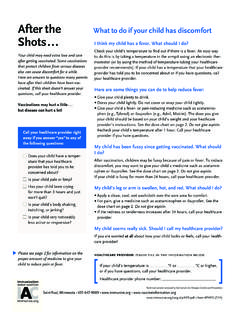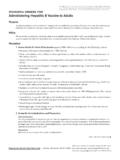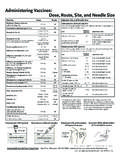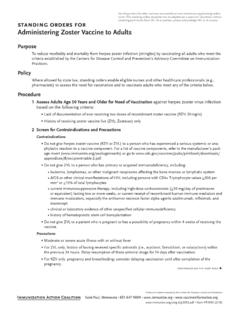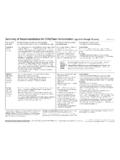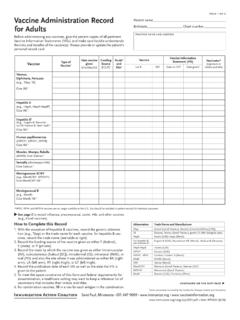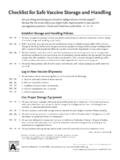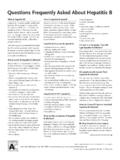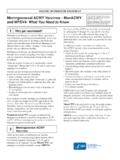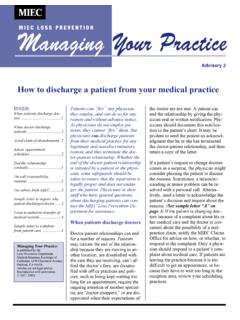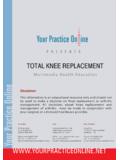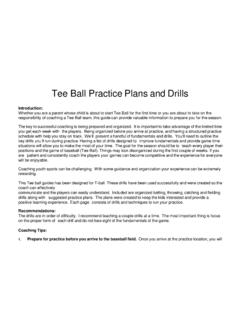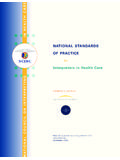Transcription of P3067 Ten steps to implementing standing orders for ...
1 10 steps to implementing standing orders for immunization in your Practice SettingIntroductionStanding orders are written protocols approved by a physician or other authorized prac-titioner that allow qualified health care professionals (who are eligible to do so under state law, such as registered nurses or pharmacists) to assess the need for and administer vaccine to patients meeting certain criteria, such as age or underlying medical condition. The qualified health care professionals must also be eligible by state law to administer certain medications, such as epinephrine, under standing orders should a medical emer-gency (rare event) standing orders in place streamlines your practice workflow by eliminating the need to obtain an individual physician s order to vaccinate each patient. standing orders carried out by nurses or other qualified health care professionals are the most consistently effective means for increasing vaccination rates and reducing missed opportunities for vaccination, which improves the quality of care for patients.
2 standing orders are straightforward to use. The challenge is to integrate them into the practice setting so they can be used to their full potential. This process requires some preparation up front to assure everyone in the practice understands the reasons why standing orders are being imple-mented. Suggested steps to help you work through this process are shown 1: Get Ready Build Support of Leadership step Discuss the benefits of implementing standing orders protocols with the leadership (medical director, clinicians, clinic manager, lead nurses) in your medical setting. standing orders will: Facilitate efficient assessment for and administration of influenza vaccine in your practice. Improve influenza vaccination rates in your practice. Protect more of your patients from influenza. Empower nurses and/or other eligible staff to use standing orders to protect more patients. Decrease opportunities for influenza transmission in your health care is important to get buy-in from physician and nurse leadership from the this guide focuses on implementing standing orders for influenza vaccination, the basic principles included can be used to implement standing orders for other vaccines and for any age group desired.
3 Technical content reviewed by the Centers for Disease Control and PreventionImmunization Action Coalition Saint Paul, Minnesota 651-647-9009 Item # P3067 (6/16)Medical Director This person is responsible for signing the standing orders protocols or supervises the clinician who signs them, so it is critical that he/she agrees with the need for standing orders and supports their use. Clinician Determine which clinician will review and sign the standing orders protocols for the Identify issues that might lead to any resistance among other Leaders Involve nurse leaders in the planning from the start. Nurses are the key players in implementing and carrying out standing orders possible, determine the influenza vaccination rate in your practice prior to meeting with leadership. Measured vaccination rates are inevitably lower (sometimes much lower) than perceived rates. Lower-than-expected vaccination rates will help support the need for a standing orders appropriate for your medical setting, you also may want to discuss the standing orders protocols with your legal counsel to be sure they comply with all applicable state requirements.
4 step Identify the person who will take the lead and be in charge of your standing orders program. In most practices , the lead person will be a nurse, nurse practitioner, or physician assistant. The lead person must be an influential leader who has medical knowledge, understands the standing orders protocols, and is able to answer questions about them from other staff members. The lead person must be motivated to protect patients by improving the adult vaccination levels in your practice a true immunization champion. step Reach agreement about which vaccine(s) your practice will administer using standing may be best to start using standing orders only for influenza vaccine if you have not implemented standing orders previously. Later, when staff are trained and know how standing orders work, you can expand their use to additional vaccines. standing orders work well for improving coverage for child, adolescent, and adult Phase 1 means you are on your way.
5 You have buy-in from your medical director and clinicians, buy-in from nurse leadership, have identified your immunization champion to lead the effort, and have decided on the vaccines you want to provide. Now you re ready to move to Phase 2: Get Set Develop Materials and Strategies step Create standing orders protocols for the vaccine(s) you want to administer. Don t reinvent the wheel! The immunization Action Coalition ( ) has standing orders templates for all routinely recommended vaccines available to download at org/ standing - orders . IAC standing orders are reviewed by the Centers for Disease Control and Prevention (CDC) for technical accuracy. You may use IAC s standing orders templates as written, or you may modify them to meet your practice s Action Coalition 10 steps to implementing standing orders page 2* Have the standing order (s) reviewed and signed by the medical director or clinician responsible for the program.
6 Note: immunization Action Coalition (IAC) also has standing orders templates available for manag-ing vaccine reactions, which include the administration of medication. These templates are available at for adults and at for children. step Hold a meeting to explain your new standing orders program to all staff members. It is crucial that all staff understand the program because they will all be involved directly or indirectly. To get buy-in from staff, you will need to explain WHY you are starting this program. Some of the reasons are shown in the box below: Review how standing orders work and the specific protocols and procedures with all staff members who will be involved. step Determine the role various staff members will play in implementing /using standing orders . Here are some general and specific questions that will help you plan:WHO in your practice: is eligible under state law (RNs, pharmacists, others?)
7 To assess a patient s vaccination needs and provide vaccinations using the standing orders protocols? can help determine the need for a patient to be vaccinated? (For example, the receptionist or the person who rooms patients can inquire if they have had their influenza vaccine yet this season.) will check the patient s chart to find out if they need vaccinations? will provide screening checklists for contraindications and precautions to patients, and who will review the patients answers. (available at ) Can these questions be added to your electronic medical record (EMR)?56 Disease should be prevented whenever possible, and vaccines can do this. Our patients are counting on us to keep them healthy. Adult vaccination rates in the United States are low and significant racial and ethnic disparities exist. Vaccination levels among adults are inadequate in most practices . standing orders have been demon-strated to streamline the assessment and delivery of immunizations in medical practices .
8 The burden of disease as a result of vaccine-preventable diseases is seen not only in increased morbidity and mortality, but also in increased costs to the health care are we starting a standing orders program? immunization Action Coalition 10 steps to implementing standing orders page 3 WHO in your practice: will give Vaccine Information Statements (VISs) (legally required documents given before vacci-nation) to patients? ( ) will administer the vaccine? will ensure the patient s personal record is updated and given to the patient?WHAT is the role of: the front desk staff? How can they help? the nurse? the medical assistant?WHERE in your practice: will vaccine be administered? will vaccine administration information be recorded ( , EMR, paper document in medical chart, state/local immunization information system or registry )? If you don t use an EMR and don t already have a medical record chart form for vaccination, you can use the immunization Action Coalition s record forms for adults ( ) or children ( ).
9 step Determine your standing orders operational strategy. Review your existing vaccination services logistics. Are there ways to improve patient vaccination and flow and to maximize your office immunization rates?Here are some proposed modifications to consider: Assess the influenza vaccination status of every patient who enters the office by asking the patient directly and checking the chart. Consider providing vaccinations in an easy-to-access site in your practice, separated from the normal traffic pattern through the office. Consider offering vaccinations under standing orders on a walk-in basis. Discuss expanding your vaccination services when using standing orders . For example, can you: Hold vaccination clinics on evenings or weekends? Have nurse-only visits for vaccination? Offer express service for vaccination during regular office hours for both patients with appointments and those who are walk-ins ?
10 If you use an EMR, consider whether the standing orders protocols and screening questionnaires can be added as prompts within your existing system. If viable in your clinic setting, determine your current immunization rates so you will be able to measure your improvements after implementing standing orders . 7 immunization Action Coalition 10 steps to implementing standing orders page 4(continued) step Identify strategies and publicize your program to your patients. your enhanced vaccination program is of more value if your patients know the service is available. Review your current methods for contacting patients, , appointment reminders, laboratory results, prescriptions, online communications, text messaging, etc. Can these methods also be used to tell patients about their need for vaccination and the availability of a convenient new program? Consider whether your existing communication systems are sufficient to inform patients about enhanced vaccine availability.
